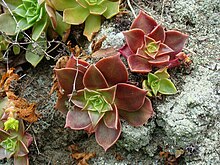Dudleya stolonifera
| Dudleya stolonifera | |
|---|---|

| |
| Scientific classification | |
| Kingdom: | Plantae |
| Clade: | Tracheophytes |
| Clade: | Angiosperms |
| Clade: | Eudicots |
| Order: | Saxifragales |
| Family: | Crassulaceae |
| Genus: | Dudleya |
| Species: | D. stolonifera
|
| Binomial name | |
| Dudleya stolonifera Moran
| |
Dudleya stolonifera is a succulent plant known by the common name Laguna Beach liveforever. This is a rare plant which is endemic to the coastline of Orange County, California. It is known from only about six populations in the vicinity of Laguna Beach, totalling about 30,000 individuals.[2] It is federally listed as a threatened species of the United States.
Description[]
This Dudleya grows from an unbranched caudex stem and is unusual among related plants in that it has stolons from which it sprouts vegetatively. Dudleya stolonifera produces a small rosette of pointed reddish-green leaves and erects a short stem topped with an inflorescence. The flowers are bright yellow.
Ecology[]
Dudleya stolonifera grows on steep, weathered sandstone cliffs, mostly in coastal sage scrub habitat, and sometimes in chaparral.[2][1] The cliffs are so steep they may be vertical or overhanging.[3] It grows in very thin soils that support very few types of plants; the dudleya is usually found among only mosses and lichens, and sometimes the fern California polypody (Polypodium californicum). It may have an association with the lichen , which might act as a bed for the seeds of the dudleya when they fall to the ground.[2]
This species sometimes hybridizes with Dudleya edulis in the one area where they occur together.[3] Less often it hybridizes with Dudleya lanceolata.[2]
Conservation[]
This rare plant faces a number of threats to its survival. The effects of urban development may harm the plant. The habitat is too rugged in most areas to be directly developed, but associated changes to the habitat from nearby development may include the edge effect. When the plant was listed as threatened it was plucked from the wild by plant collectors; this is no longer thought to be a serious problem because the occurrences are too difficult for people to access. Grazing and trampling by livestock had a negative effect on the plant but grazing has been stopped in the area, causing the plant to rebound. Climate change is considered a threat today. Because the populations are few and small the plant may be extirpated by any major local event, such as wildfire, or by processes such as inbreeding depression.[2]
Competition with other plants, especially non-native species, threatens the dudleya. In one area it is being displaced by invading Aeonium haworthii.[2]
References[]
- ^ Jump up to: a b Dudleya stolonifera. The Nature Conservancy.
- ^ Jump up to: a b c d e f USFWS. Dudleya stolonifera Five-year Review. April 16, 2010.
- ^ Jump up to: a b Dudleya stolonifera. Flora of North America.
External links[]
- NatureServe critically imperiled species
- Dudleya
- Endemic flora of California
- Natural history of the California chaparral and woodlands
- Natural history of Orange County, California
- Taxa named by Reid Venable Moran
- Critically endangered flora of California
